A LITTLE ENCOURAGEMENT FOR HOUSTON’S LIGHT-RAIL STRAGGLER Metro’s University Line has passed its final environmental review, the transit agency announced today. “The approval in the form of a federal Record of Decision allows Metro to go forward with utility coordination, design and pre-construction planning along the 11.3-mile route, some of which will run along Richmond Avenue from roughly Main to Cummins streets.” [River Oaks Examiner]
Tag: Light-Rail
BACKING OFF THAT EXCLUSIVE Metro’s new board voted today to revise the notable exclusive 3-year contract the previous regime had signed last December with real-estate consultants McDade Smith Gould Johnson Mason + Co. The arrangement would have awarded the commercial brokerage firm up to $6.25 million in commissions on land transactions related to the construction of 5 new light-rail lines, as well as additional consulting fees. At the time of the signing, 2 of the 7 employees in Metro’s real-estate division were McDade Smith brokers. Michael Reed reports: “The new agreement with McDade Smith will be for one year and will utilize the firm only for selected properties that require their professional expertise. More work will also be done within Metro, it was indicated.†Update, 6 pm: More details on the new contract in this later story from Reed. [River Oaks Examiner; previously on Swamplot]
THE METRO LAND COMMISSION DEAL Real estate brokerage firm McDade Smith Gould Johnston Mason + Co. is slated to earn as much as $7 million in consulting fees and commissions from land transactions related to the construction of 5 new rail lines, the West University Examiner‘s Michael Reed reports. Last year’s hiring of Kristen M. McDade as associate vice president of real estate services means 2 out of Metro’s 7 real estate division employees are also McDade Smith brokers. The 3-year deal approved by the outgoing Metro board last December outlines that payments are to be made “even though the land to be used has already been predetermined by the route and could be taken through eminent domain, if need be,” Reed explains: “As stated in the contract, ‘Consultant (McDade Smith) shall receive commissions on every transaction closed by Metro, including but not limited to all right of way acquisitions, calculated on the basis of 6 percent of the “sales price.‒ Metro, however, receives a credit of rebate equal to 40 percent of that payment, according to the contract. Since, legally, a buyer — in this case, Metro — cannot force a seller to pay commissions to a broker, Metro’s true price for land acquisition for five lines, including the University route, would likely be bumped up by $6.25 million in buyer paid commissions as well.” [West University Examiner]

Here’s a little handy graphic from Mayor Parker’s Metro transition task force, identifying what the team considers “major unresolved design issues” in the planned East End, Southeast, University, and Uptown light-rail lines. Attempts to resolve all 6 of them appear to be “bogged down” at the Metro staff level, according to the task force committee. Each problem might delay construction or increase cost, and each has already been “actively discussed” for at least a year.
What are they?
- the Downtown alignments of the East End Line and Southeast Line on Capital and Rusk streets as they cross the Main Street Line;
- how the East End and Southeast Lines and car traffic will flow around the proposed Dynamo Stadium site in East Downtown;
- how grade separation will work with a freight-rail crossing on the East End Line on Harrisburg near Hughes St.;
- details of the Southeast and University Lines near the University of Houston along Scott St.;
- how the University Line will cross and interact with Main Street Line at the Wheeler station in Midtown; and
- the design of the Uptown Line north of San Felipe, along the 610 West Loop.
Oh, and then there’s this little bit about finding the money to build it all:
EXTENDING METRO’S MAIN ST. RAIL LINE TO FORT BEND COUNTY Metro’s lame-duck board gave its staff a half-million-dollar go-ahead yesterday to figure alignments, hold public meetings, and begin environmental studies on an 8.2-mile commuter rail line along U.S. 90A. The hunt for federal funding comes next: “It was the second development this month in efforts to bring commuter rail to the Houston region. The Gulf Coast Rail District recently hired a Houston engineering firm to study a line along U.S. 290 to Hempstead. A key advantage of Metro’s [Fort Bend] plan, [Chairman David] Wolff said, is that it would use trains Metro already owns on tracks that would parallel Union Pacific freight tracks in the same corridor, tying into the existing Main Street light rail line to create a seamless experience for passengers. The commuter line would begin at Fannin South, the southern end of the Main Street line, and continue to the Fort Bend County Line at Beltway 8.” [Houston Chronicle]
MAYOR PARKER: MAYBE WE CAN’T BUILD THE UNIVERSITY OR UPTOWN LIGHT RAIL LINES Suddenly, 2 of Metro’s 5 planned new light-rail lines are looking a lot less inevitable: “Parker said members of her transition team have ‘drilled down’ into Metro’s finances and she now feels comfortable only with the funding plans of three rail lines: the East End, North and Southeast. Construction on those lines is under way. Parker’s goal is to make sure those three lines are built “very, very rapidly,†she said. The other two, the Uptown and University lines, ‘are lines that I want to see built, but until we can finalize all the numbers, and some of them are still moving, I’m not going to commit to whether that is possible.’†[Houston Chronicle]
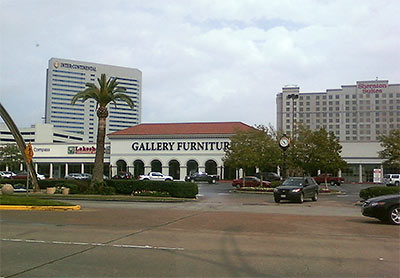
At a meeting last week at Kenny & Ziggy’s Deli organized by Jim “Mattress Mack” MacIngvale, owners of businesses located along Post Oak Blvd.’s vast double phalanx of front-loading strip centers — and representatives of a few of their landlords — groused about Metro’s design for the new Uptown Line and prepared for possible battle. The Examiner Newspapers’ Michael Reed first brought attention to a few quirks of the latest design for the Post Oak stretch of the light-rail line late last year: It features 7 stations, 5 gated crossings, and in all close to 2 dozen traffic signals along the 1.7-mile path from Richmond Ave. to the 610 West Loop. It also blocks all instances of that staple of sprawl-style shopping-center development: the non-intersection left turn.
Had Metro been communicating its plans to the property owners? Had the property owners been relaying any information they received from the transit agency to their tenants?
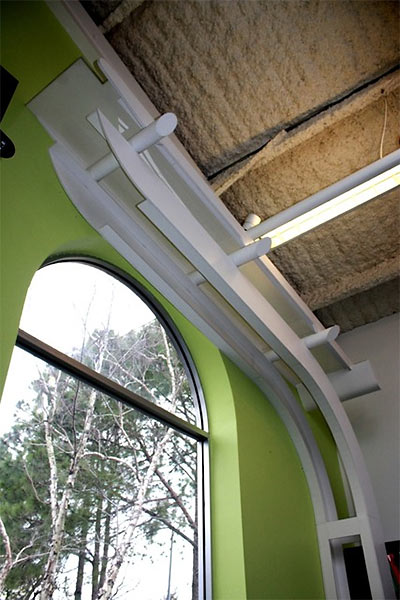
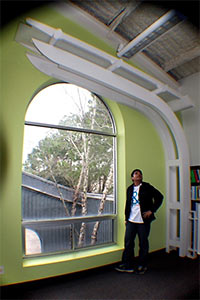
What are the stations for the new Metro light-rail lines gonna look like? This full-scale mockup of a section, cobbled together from foam core, poster board, cardboard mailing tubes, and Plexiglas, now waiting way off-site in the offices of RdlR Architects provides one clue.
And here are a few more:
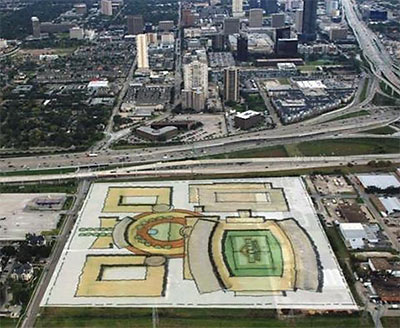
More details on that newly proposed alternate location for Dynamo Stadium that the soccer team is now apparently considering: It’s a 30-acre parcel at the southeast corner of Westpark and S. Rice Blvd., across from the Sam’s Club parking lot and Bubba’s Texas Burger Shack. That’s just southwest of the intersection of 59 and the 610 Loop, and right next to the planned location of the Uptown and University light-rail lines’ Bellaire Station — at Westpark and North 1st St.
Brad Feels, CEO of Midway Companies, tells the Chronicle‘s Chris Moran he’s envisioning a mixed-use development there somewhat like Dallas’s Mockingbird Station, which sits just across the Central Expressway from SMU’s Ford Stadium, and which features restaurants and retail, office buildings, apartments, and a movie theater complex. (Midway is the developer of CityCentre, now pretty much complete at the site of the former Town & Country Mall.) Feels first contacted the Dynamo’s Oliver Luck with information about the property in October or November of last year.
What’s happening with plans to build a Dynamo Stadium in East Downtown?
COMMENT OF THE DAY: MAKES IT EASIER TO CRUSH THOSE COMMUNARDS, TOO “Parisian city planners were met with similar narrow-minded criticism when they decided to construct grand boulevards in medieval Paris. The result was the Champs-Elysees and other notable conduits. The visionaries at METRO must ignore similar insuferable fools and carry on the worthy goal of bringing automobile independent mass transportation to Houston. The University line is the lynch pin of the ongoing expansion and these plans should be approved with all deliberate speed.” [Landed Gent, commenting on Metro’s University Line Acquisition Line-Up: What Stays and What Goes Along Richmond Ave.]
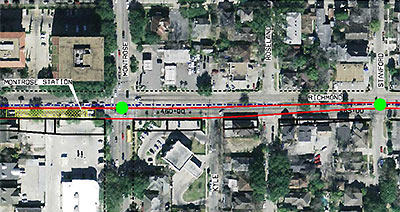
Did 3.2 acres of acquisitions along Post Oak Blvd. for the new Uptown Line sound like a lot to you? Then look at this: The Final Environmental Impact Statement for the new University Line says Metro’s “locally preferred alternative” route will need to acquire 23 acres of land from approximately 212 separate parcels on that route, most of it along Richmond Ave. (Only 7 of those parcels will need to be acquired in full, according to the report.) Plus: 100 businesses, 30 residences, and 38 mixed-use structures will need to be relocated.
Potential acquisitions and displacement are expected at signalized intersections and at some transit stations. Every transit station located on the street will have a traffic signal. Additional right of way will be needed to accommodate left-turn lanes at key signalized intersections.
You can find the complete list of affected properties beginning on page 146 of this document. Maps of the targeted properties along the entire route — similar to the bit along Richmond Ave. at Montrose Blvd. shown above — are in the engineering drawings section.
Find anything interesting in there? Let us know in the comments!
- Rail along Richmond requires 23 more acres: report [West University Examiner]
- University Corridor Updates [Metro Solutions]
- Previously on Swamplot: Trimming Uptown Trees and Driveways: Where Metro Is Shopping for Land on Post Oak Blvd.
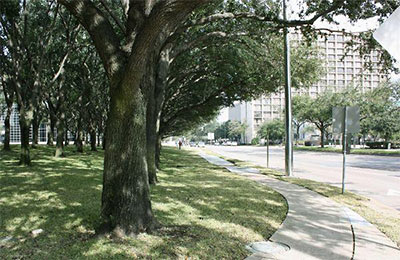
Metro’s most recent street reclassification plan indicates that the transit authority will need a grand total of about 3.2 acres of land on Post Oak Blvd. to squeeze in its new Uptown rail line, reports the River Oaks Examiner‘s Mike Reed.
The most notable target of Metro acquisition efforts will likely be a roughly 14-ft.-wide swath of tree-lined land along the Post Oak edge of the newly minted Gerald D. Hines Waterwall Park, pictured above. The Williams Tower immediately to the north is due the same sort of trim, because the Hampton at Post Oak assisted living facility across the street is located much closer to Post Oak.
An even bigger bite would be taken out of the west side of Dillard’s if the current design goes forward: a 29,476-sq.-ft. strip that “would appear to include the ramp leading to the second-story of the garage,” Reed reports. The Galleria itself would lose only 1,019 sq. ft.
There’s a whole lot more in the plan. In all, pieces of 48 separate parcels are on Metro’s Post Oak shopping list so far:
LIGHT RAIL CONSTRUCTION AND THE GORILLAS’ LAST STAND The latest idea from Metro: Create official signs, flags, and banners for businesses along light-rail construction routes, to show they’re still in business, and to guide cars into open parking areas. Only problem? “Some of the proposed flags would flutter afoul of the city’s newly tightened sign ordinance, which bans certain types of ‘attention-getting devices.’ City Council may have to approve a small change in the city’s sign law to allow temporary banners to stay up for longer than the allotted seven out of 30 days, according to city public works official Andy Icken. . . . The city’s new sign ordinance kicks in on Jan. 1. It bans the giant inflatable balloon animals and other eye-catching gizmos that you often see on Houston’s highways and roads. So enjoy the giant ‘For Sale’ gorillas while you can. Also, the dancing wind socks along the side of the road, the silver and blue streamers at car dealerships, and the other pennants, pinwheels and puppets meant to pull your gaze from the road to the roadside.” [Houston Chronicle; previously on Swamplot]
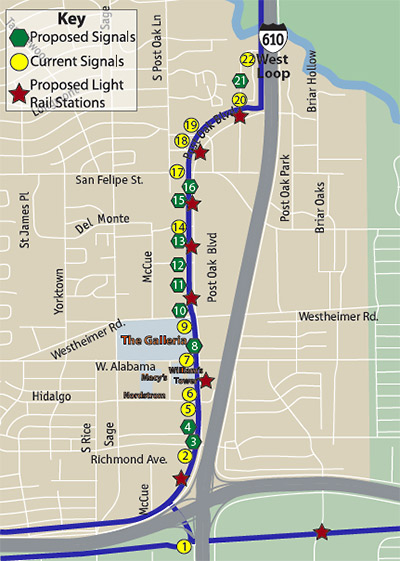
Once the new Metro Uptown light-rail line is built, Post Oak Blvd. could feature more than 23 stoplights along its 1.7-mile stretch between Richmond Ave. and the 610 Loop, reports the River Oaks Examiner‘s Mike Reed. A report prepared last October by the group of companies contracted to build the new Uptown Line lists 21 stoplights and 7 stations.
But that information’s got to be out of date, right?
. . . in response to questions, a Metropolitan Transit Authority spokeswoman said Tuesday that since the report was written, the number of potential signals has increased to 23, with an additional traffic light and an additional pedestrian light under consideration.
While the proposals contained in such reports are subject to change, the original document indicates the scope of the project combined with the density and development in the area would make substantial alterations to the plan difficult at best.
Reed also reports a few details on the rebuilding of Post Oak:
JOHN CULBERSON TO METRO: STOP THIS TRAIN! After poring through financial documents on the Metro website that the organization’s chairman now says are outdated, Congressman John Culberson announces his opposition to federal funding for the light-rail University Line — because he’s concluded that Metro won’t be able to afford it: “Culberson filed a formal objection with the Federal Transit Authority late Tuesday, ahead of a deadline today for members of Congress to file any concerns. Otherwise the FTA would have given Metro the nod to begin preliminary engineering work on the line. Part of the 10-mile route lies within Culberson’s congressional district. FTA spokesman Paul Griffo said the agency retains the final say. ‘It is not a process that requires explicit congressional approval or disapproval,’ Griffo said. ‘The FTA will keep Mr. Culberson’s concerns in mind, as we do the concerns of all elected officials, as projects advance through our evaluation process.’†[Houston Chronicle; more detail in the River Oaks Examiner]

